Babywearing can be beneficial for both baby and parent, but as with other baby products, it’s important to use baby carrier with safety in mind.
Whether you’ve already started babywearing or you’re an expectant parent and only think about buying a baby carrier, here you will find all information on how to make babywearing a safe activity for the baby and you.
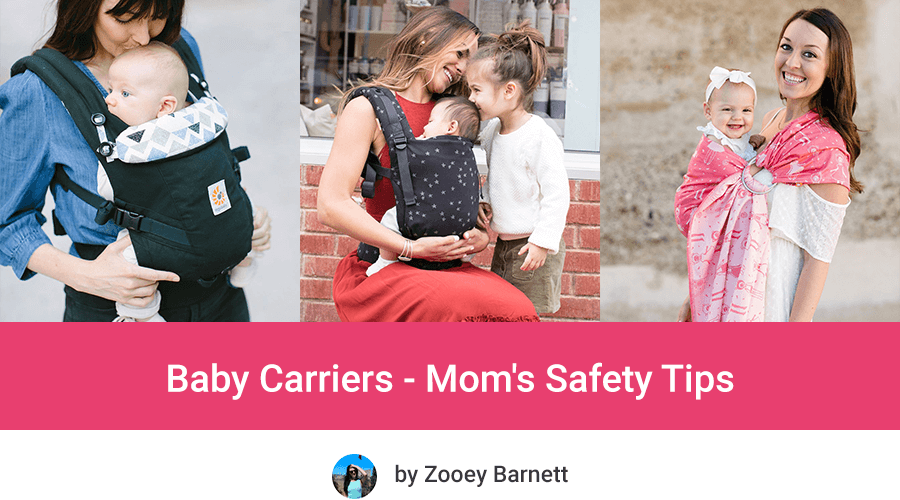
As you may have already know babywearing can be very useful. It’s practical if you have more than one child, it helps parents to take care of household chores, when you need to prepare a meal, as well as for going out on your own for example to the mall or getting through crowded places like airport.
Moreover, using a baby carrier may sooth a fussy newborn or help baby with reflux. When you’re carrying the baby on your front, he feels the movement of your body, of your belly – which works kind of like a massage for his belly. It may really help with colic.
Newborn baby remembers your moves, your heartbeat from the time when he was in your womb. That’s why babywearing can be very soothing for the infant – he can feel similar to way he felt in your womb during these 9 magical months. It also helps to regulate newborn’s body temperature.
And of course babywearing has also emotional benefits, both for the baby and caregiver – it gives sense of closeness, security and love.
All of that sounds inviting, but if you want babywearing to be favorable for you and your baby, it requires a bit of knowledge and practice. Only when you’re familiar with baby carriers safety rules, babywearing can be beneficial, comfortable and enjoyable for you and your little one.
Basic Safety Rules For Babywearing
Whether you want to carry your baby in a wrap, ring slings, mei-tai, soft structured carrier or other type, there are few basic rules that you need to follow.
There is the TICKS Rule for Safe Babywearing checklist, prepared by The British Association of Babywearing Instructors1. It makes it easier to remember the safety rules.
TICKS Rules should be followed regardless the type of the carrier and baby’s age.
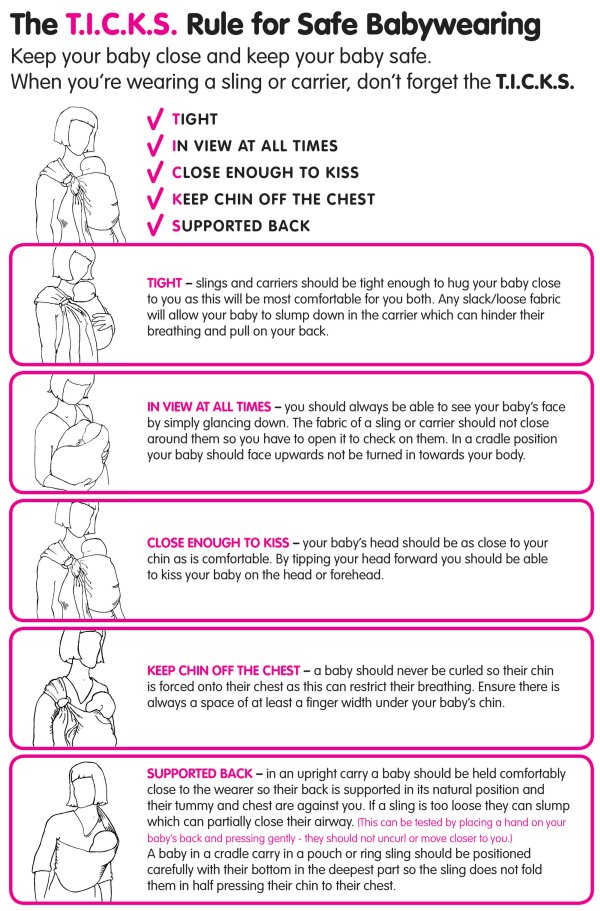
There is also ABC checklist made by Babywearing International2. On their website you can read more about safety rules and see useful pictures how to position the child in a carrier.
A – AIRWAY – Check the baby in carrier often and monitor baby’s breathing. Make sure the baby’s airway is always open. It’s most easy to do when the baby is in upright position. Baby’s chin should be off the chest (there should be enough space for one or even two fingers under baby’s chin). Baby’s nose and mouth cannot be blocked by anything, the air should circulate around baby’s face easily. You should be able to always see baby’s face. Moreover baby’s head should be close to your chin so you could kiss it just by tipping your head forward.
B – BODY POSITIONING – The carrier should provide appropriate support for baby’s neck and back. Ideally, baby’s knees should be higher than the bottom and the legs should be in spread-squat position (M-like shape) and the carrier should prevent the baby from slumping. Baby’s weight should be borne by thighs and bum. It is recommended to carry infants in vertical position. If you want to nurse the baby in a carrier, try the cradle or horizontal position but return to the vertical position as soon as you have finished breastfeeding. If the carrier allow the baby to rest in natural, ergonomic position, it is also more comfortable for the wearer.
C – COMFORT – Don’t forget that the carrier should feel comfortable for you and the baby. If you’re not confident about your carrier, you should keep a spotter nearby, in case you need some help.
Moreover, regardless the type of baby carrier you’re using, check it frequently for any damages or signs of wear like worn fabrics or loose stitching, which may decrease its safety quality. If you notice such things, consider contacting the manufacturer.
If you’re a babywearing-beginner practice using and adjusting the carrier with a spotter or at least over a bed/couch until you feel confident about it. It’s important especially with wraps that require learning how to make a secure tie, as well as using a baby carrier on your back.
| PRO TIP: Choose carriers only from reputable brands and make sure the model you are going to buy meets the safety rules and standards in your country. You may also want to check if the baby carrier you’ve chosen is on the Hip-Healthy Products List3, created by The International Hip Dysplasia Institute. |
Ergonomic Position: Frog Position
Lots of parents often ask: “Are baby carriers safe for baby hips?” The answer is actually quite simple: if you carry the baby in proper position it supports good hip development or even may prevent the baby from hip dysplasia and dislocation.
Now you may ask what is the proper, safe position for the infant in a baby carrier. In this paragraph I will explain how to position baby’s hip in a healthy way to promote natural hip development.
According to the International Hip Dysplasia Institute, the healthiest position for the baby in a carrier during the first few months is the position called frog position, spread-squat position, straddle position or jockey position (they are all the same, these are just different names).
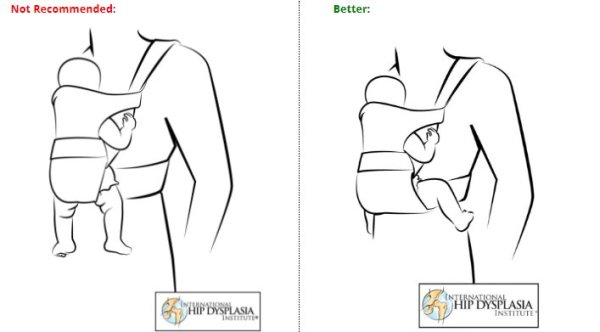
In this position baby’s hips naturally fall or spread apart to the side, the hips and knees are bent and the thighs are supported. Hips movement is not blocked. Moreover hips should not be forced together. Such position encourage normal hip development. You should use this position when you carry the baby (whether in a baby carrier or in your arms), especially during the first six months of baby’s life.
The newborns legs should be in M-like position (check picture below). They can be inside the carrier or outside, but always supported from knee to knee, with knees higher than bum. The arms should also be inside the carrier, but as the baby gains neck control you can put the arms out.
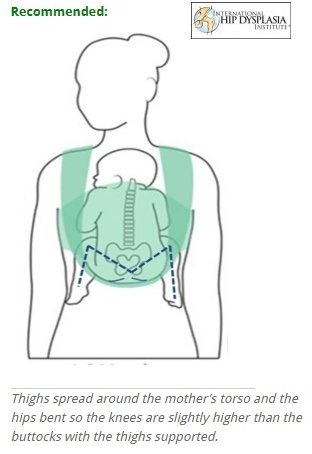
Also, infant back should be naturally rounded. Don’t use a carrier that force the baby to straighten his spine too early. As the baby grows, his neck control develops and spine strengthens naturally (usually between 6 and 12 month).
It’s important to check if the back panel is at appropriate height and gives proper support, accordingly to baby’s age.
If the baby carrier is used properly the newborn baby should maintain natural, safety position:
- Hips and knees bent
- Knees higher than the bottom or at least at the hip level (M-liked shape, bent at 110°-120° angle)
- The straddle should be at about 60° and gradually should increase up to 90° as the baby grows
- Baby’s feet rotated to the outside
- C-shaped spine (baby’s back is naturally rounded after birth) and baby’s head supported by wearer’s chest – Thanks to that weight of baby’s head doesn’t burden his spine and each vertebra is protected and the whole spine is well supported by the wrap/sling/carrier
Never position the infant into artificially upright position and don’t force his spine, hips and knees to be straighten too early.
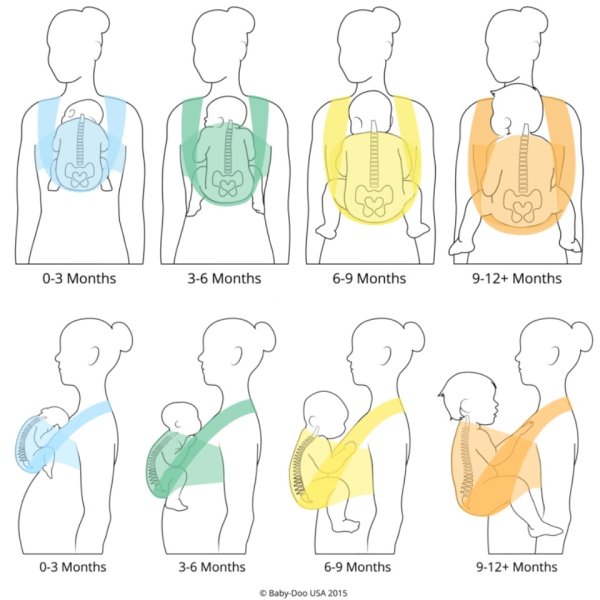
You may also want to ask why this particularly position is the safest one for the infant baby.
Well, this is the most natural position for the baby, after spending 9 months in mom’s womb in a fetal position (with hips and knees bent or flexed). Newborn baby naturally pose his legs and knees in such position. We can even say that the newborn is naturally positioned to be carried in a wrap, because the carrying position is similar to the way he was carried in a womb. Babywearing also helps the newborn to gradually get used to the new surroundings.
After the birth joints stretch out naturally but it takes several months, therefore it is especially important to carry the baby in frog position during the first (about six) months. If the baby was in the breech position stretching out the joints may last longer.
Carrying an infant in frog position (whether you’re using wrap, ring sling or buckle carrier) helps the hips to develop naturally and may prevent from dysplasia.
| PRO TIP: Spread-squat position is most natural for newborn baby, but don’t position baby’s legs too wide – with straddle above 90 degrees (and all the way around your waist). It’s not good for baby’s hips and force the baby to straighten his lower back too early. |
Risks Of Using Baby Carrier – Hip Dysplasia & Dislocation
If you’re using position your baby in a carrier properly, it won’t interfere with hip development. However if the baby is held in unhealthy position it may increase the risk of hip dysplasia or dislocation.
What carrying position is unhealthy for the infant?
- Legs are held in extension and forced together
- Hips and knees are straight
This position is actually the opposite of the fetal position. If the baby maintains such position for an extended period of time, the potential risk of abnormal hip development is greater.
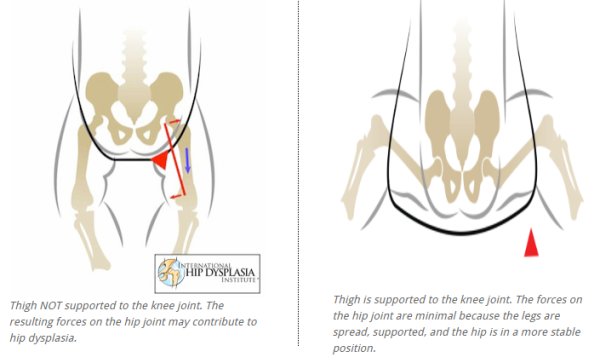
What is hip dysplasia & dislocation?
During the first few months of life, as the joint are stretching out naturally, the ball of the hip joint is more likely to be loose within the socket. Hip dysplasia is when the edges of socket joint (which is shaped like a cup) are permanently deformed by the ball. The risk of this disorder is greater when the hips are forced to stretch out too early.
That’s why if the baby cannot rest in frog position in a carrier and his hips are straighten unnaturally it may increase the risk of hip dysplasia.
Hip dislocation is when the ball is slipping out of the socket in the hip bone.
What’s noticeable both disorders are not painful for the baby and may go unnoticed until walking age.
Keep in mind that the risk of these disorders is the greatest in the first few months of life (when the baby is naturally flexible and the edges of the socket joint are made of soft cartilage). That’s why it is important to know how to position the infant in the carrier.
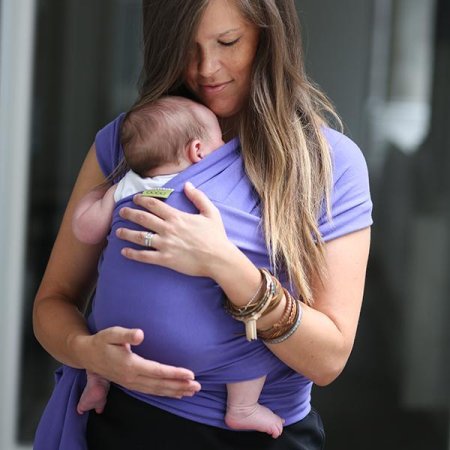
Most 6-month-old babies have more developed hips and their ligaments are stronger therefore the risk of developing hip dysplasia is lower.
So if you were wondering: “Are baby carriers safe for newborns?” the answer would be “Yes, but only if you’re using them correctly”.
| PRO TIP: Avoid baby carriers that have narrow sitting area and don’t support baby’s legs from knee to knee. In such carrier baby’s weight put strain on the crotch and pelvic area and baby’s legs are artificially straighten and hang loosely. This is not a natural position for infant baby, and definitely it’s not healthy! Baby’s spine is force to be straight, therefore it’s not properly supported. Moreover hips are not bent or stabilized which in turn may have negative impact on their development. |
Of course the safety rules are not everything. If you have any doubts or you’re uncertain how to use the baby carrier, you should discuss it with your pediatrician and/or qualified babywearing instructor.
When Can I Carry My Baby In A Carrier?
Remember that it’s important not only to position baby’s hips properly, but also choose the baby carrier size accordingly to child’s age and size.
Parents who are thinking about starting babywearing often wonder: “Are wraps suitable from birth?”, “Are ring sling safe for newborns?” and “When can I start using baby carrier?”.
First of all, there is a wide choice of different types of baby carriers (you can read more about all types here) and some of them are usable from birth.
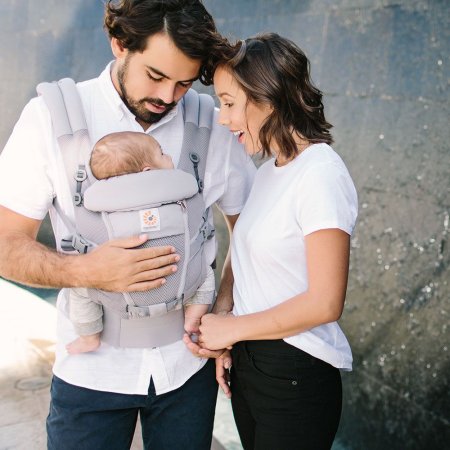
Both wraps and ring sling are suitable for newborn babies. To use them properly parents need to position the baby in a frog position, with M-shaped legs and rounded back. The fabric should snuggle the baby tightly and properly support his head.
Some of the soft structured carriers are also usable from birth, but some require adding an infant insert below certain weight. For newborns I prefer buckle carriers that don’t require any insert as they are newborn-ready and less bulky and hot.
Of course if you want to use soft structured carrier from birth you need to choose model that allow the baby to maintain frog position and doesn’t force straightening legs and hips.
Moreover, it’s useful to have a carrier with adjustable sitting area to always support baby’s legs from knee to knee (newborn baby who weighs 7 pounds needs a different support than 10-pound newborn or 3-month-old infant). Safe baby carrier for newborn should also support baby’s delicate, curved spine and doesn’t force straightening it too early.
Newborn babies and infants up to 6 months need the biggest amount of support for their back (which is rounded at the beginning and still developing). But even when the baby can sit upright and hold his head up, he still needs back support especially when he falls asleep in a carrier, because the muscle tone decreases then.
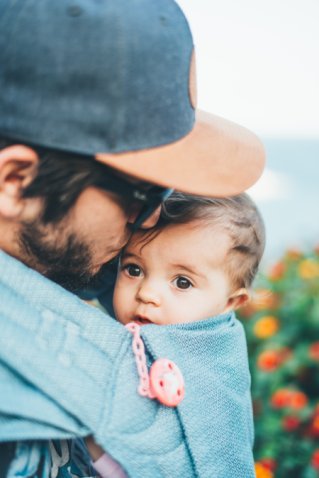
Up to 6-9 months baby should be carried facing front (tummy-to-tummy position). Until than baby doesn’t have enough neck and head control. If parents wear their babies on their front, they can control and support baby’s head when needed.
When the baby can sit unassisted and can hold his head up, you can start carry him on your back. It’s beneficial for the baby because at this age the child is more curious about the surroundings and wants to observe everything around.
Whichever carrier you’re using and regardless the position you prefer, always prevent baby’s legs from hitting your legs.
Keep in mind that the baby carrier should be safe and comfy not only for the baby, but for the wearer too! The best carriers are the ones that allow for even distribution of baby’s weight across wearer’s body.
Here I can recommend using wraps (Boba Wrap or Baby K’tan Wrap) or buckle carriers with adjustable straps and wide waistband (like Baby Tula Free-to-Grow, Lillebaby Complete or Ergobaby Omni 360).
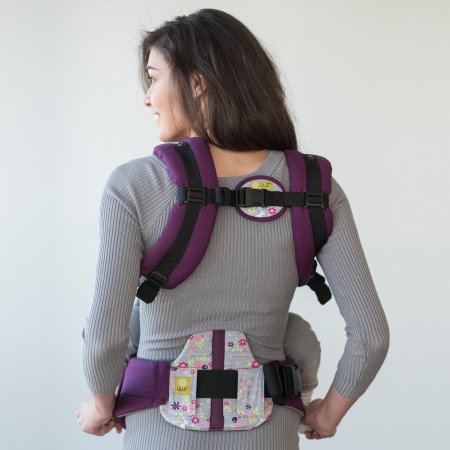
Are There Any Medical Contraindications For Babywearing?
You should not carry your infant in a baby carrier in case of serious illness (both yours and your baby), for example when there is constant requirement of monitoring baby’s breathing or if there are anatomical defects.
During the postpartum (around 6 weeks after the birth), mom should not carry heavy kids for extended period of time (for example older child).
In some cases, specific tying methods may be contraindicated.
If you have any doubts whether you can practice babywearing or how to use baby carrier properly, please contact pediatrician and qualified babywearing adviser. Considering the emotional benefits and the convenience of babywearing for parents, taking time to find suitable method of carrying and proper baby carrier is definitely worth the effort.
Is Facing-Out Carrier Safe? – 7 Reasons NOT To Carry Your Baby Facing Out
Here’s why I’m not a fan of facing-out position.
- Baby’s legs are not properly supported in this position, they just dangling. The child can’t bent his hips and knees to maintain more ergonomic position, healthier for developing hip joints. Moreover if the baby’s legs are dangling, they may hit wearers legs which also has negative impact on hips.
- In facing-out position baby cannot maintain naturally rounded curve of his back. When facing-out the position of the pelvis forces baby to straighten his spine unnaturally. In this position baby’s spine leans on wearer’s chest which also pushes the spine forward, as the wearer is moving. It forces baby spine into a “hollow back” position and baby has to carry the weight of his body and heavy head. That’s a lot of pressure on a delicate, still developing spine. Moreover, if the baby doesn’t have proper neck control, his chin may fall on his chest which in turn may make breathing difficult (risk of asphyxia!).
- The carrier doesn’t support baby’s back and neck and doesn’t protect his spine and head from shocks as the wearer is moving. Baby’s head is bouncing and shaking.
- This position puts the biggest pressure on baby’s crotch. It’s not only uncomfortable for the baby, but the pressure on the groin may have negative impact on the blood flow too!
- Baby is exposed to too many stimuli in the surrounding. When there is too many impressions or when they are unpleasant, the baby cannot hide or cuddle in. In this position baby doesn’t hear mom’s or dad’s heartbeat, doesn’t have an eye contact with parent therefore it’s harder for him to calm down when something scares him. It’s also more difficult for the baby to fall asleep.
- You don’t see your baby’s face and you cannot respond to baby’s cues. There is no eye contact, you can’t even check if baby’s airways are clear. In this position it’s harder to respond to baby’s needs.
- This position is also uncomfortable for the wearer. It shifts the center of gravity forward. To maintain balance, parent bends backward, which strains his back muscles and spine.
How To Dress The Baby For Baby Carrier
It’s very important to dress the baby accordingly to the weather, but also remember that the carrier counts as a layer of clothing. If you use wrap that has 3 layers – these are three layers of clothing.
If you want to dress baby in onesie, choose something more loose, not tight. Moreover as you’re putting baby in a wrap or buckle carrier make sure the fabric of his clothes is not folded and doesn’t cause pressure on baby’s skin.
Using Baby Carrier In Winter & Cold Weather
It’s important to protect the baby from overheating as well as from cold. Babies, more than adults, are sensitive to extreme temperatures, because their ability of thermoregulation is limited.
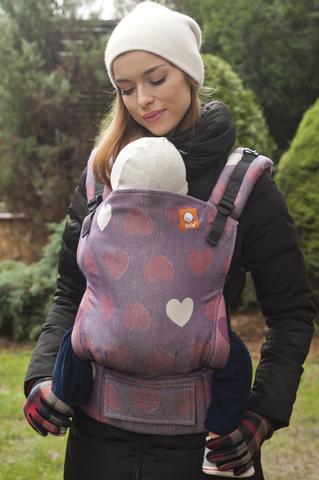
During winter and chilly weather it is better to dress the baby in layers than a bulky suit which could make positioning the baby much harder or even impossible. Keep in mind that baby’s legs and head require extra protection from cold.
If you’re using babywearing coats or cover always check if the baby’s airway is clear.
| PRO TIP: Check baby’s temperature by touching the nape of the neck. Do not check baby’s temperature by touch his arms or legs as the circulation there is weaker and these parts may be a bit colder. |
Also, be extra careful when walking on snowy or icy sidewalks. Always wear appropriate shoes for such weather conditions.
Using Baby Carrier In Summer & Warm Weather
Remember that carrier is another layer of clothing. Protect the baby from overheating and reduce the layers. You can always choose carrier made of mesh breathable fabric that allows for nice air circulation.
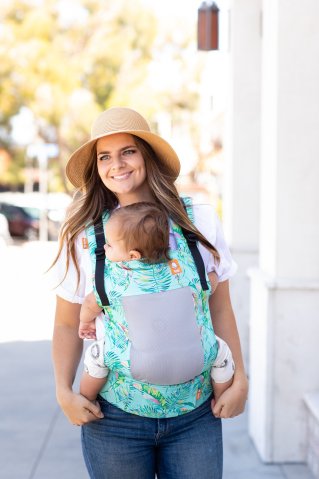
Ensure baby’s airways are clear and nothing is covering baby’s mouth and nose.
Keep your baby well hydrated (and don’t forget about your bottle of water too!).
Also, it’s better to go for a walk somewhere where you can find shade. Always protect baby’s skin from sun and wind by using a breathable, thin layer and suncream. Baby should also wear a breathable hat.
The purpose of this article is informative. Remember: safety first! Before you start babywearing consult this with a qualified babywearing advisor and pediatrician!
References:
https://www.nct.org.uk/baby-toddler/everyday-care/everything-you-need-know-about-slings-and-carriers
https://hipdysplasia.org/developmental-dysplasia-of-the-hip/baby-wearing
https://bwi.mystagingwebsite.com/what-is-babywearing/safety
Sources of pictures:



My daughter completely rejected the stroller, well, from the start. I think there was only a 4 month period she would ride in it. After she started walking, the stroller just went into retirement. We don’t have a car so we bike or walk everywhere.
The photo of the Baby Tula Free to Grow mesh carrier under “Using Baby Carrier In Summer & Warm Weather”… I want THAT one! Lol, do you have think link or the name of that specific design?
Hey Allie
This is the Baby Tula Free-to-grow “Electric Leaves” from Coast Mesh collection. But I’m not sure if it’s still available, they often change their collections and fashions.
I have a boba, but wanted to get your opinion on the nuroo pocket. Thanks!
Hi Jessica, I haven’t had the chance to test Nuroo Pocket!
Hi Zooey! What can I say? My sister is 8 months pregnant and we are planning to buy a suitable carrier but was completely going crazy about it as where to buy from and what to buy but your blog not only made our choice clear but enlightened about the safety measures we need to remember . I mean such detailed blog, wow!! We will always be thankful to you!
Hi Nisha! Thank you so much for your comment, I’m really happy to hear that my article was helpful for you. Please also remember that it’s useful to have a qualified babywearing adviser who will help your sister at the beginning with positioning the baby 🙂 I was a bit stressed and uncertain during first days of babywearing and having someone to help was crucial. And if you ever have any doubts consult your pediatrician.:)
Happy babywearing!